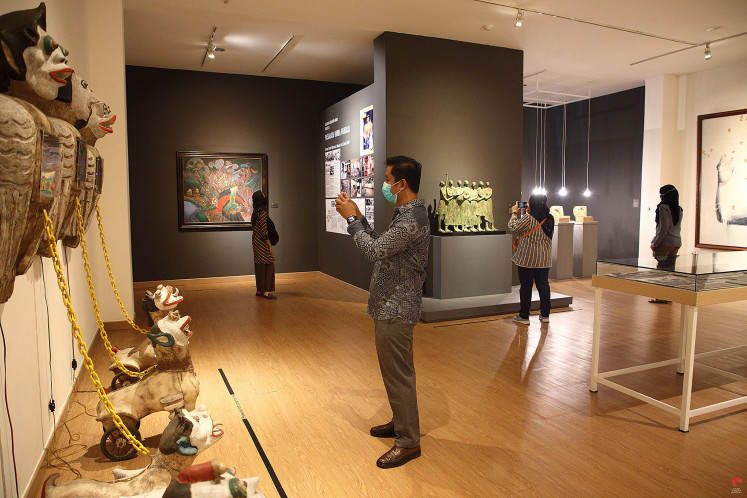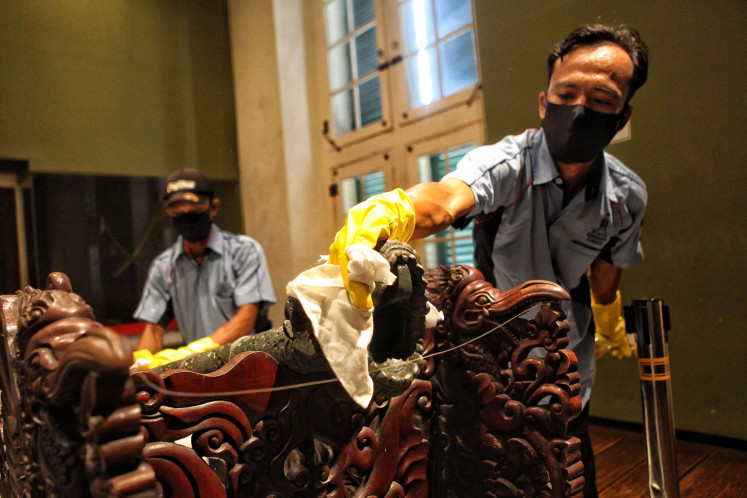Popular Reads
Top Results
Can't find what you're looking for?
View all search resultsPopular Reads
Top Results
Can't find what you're looking for?
View all search resultsMuseums prepare to take on 'new normal'
Change text size
Gift Premium Articles
to Anyone
T
he “new normal” is inevitable and comes with a fresh set of changes for cultural institutions like museums, the daily operations of which usually cater to large groups of people.
In a webinar hosted by the Mitra Museum Jakarta Foundation, Indonesian curator Annissa M. Gultom, who is director of museums at the Department of Antiquities and Museums of Ras Al Khaimah in the United Arab Emirates, said the government had been slow in reopening parts of the nation, with tourism slated to return in September or October.
“Until August, while the museums remain closed, this is a prime opportunity for us to learn. The ‘new normal’, which we don’t know what it will entail yet, will force us to radically change how we work and how we measure our effectiveness,” she said.
For example, these changes can come in the shape of revamped programs. Annissa explained that the education unit in her institution has been made vital, with real-time programs and all-new agendas on learning through a digital environment.
Keeping distance: Visitors with masks on observe artwork in the permanent exhibition room of the National Gallery in Jakarta. (National Gallery/-)“One of the most difficult units initially was the customer happiness unit, which covers frontline staff such as guides. We allocated a large amount of time to plan how they can use their time to work remotely to prepare. The collection and conservation unit has also completed training on digitization.
“The silver lining is that everyone is forced to learn. It was confusing at first, but we along with the human resources department compiled a list of courses that our staff can take,” she said.
In the meantime, a limited amount of staff still clocks in while museums are still closed, particularly the collection management, which is tasked with daily checks on displayed collections and twice a week for those in storage.
Annissa noted that this is a new procedure and will likely be part of the “new normal”.
As for planned exhibitions that are surely postponed, she said the closures had also given the team more time to develop their content to become much more involving.
Meanwhile, RM Nicolaus Aji, exhibition designer and researcher at the International Center for the Study of the Preservation and Restoration of Cultural Property’s (ICCROM) CollAsia program, said museums could become more involved with visitors by utilizing their icons, which can come in the form of brandings or unique collections.
“For example, museums can 3D-scan their iconic collections and create 3D-printed replicas they can sell to visitors. These replicas can become one of the main attractions for visitors who have fond memories of the museum,” he explained, adding that the approach could serve as an addition alongside promotional videos.
Conservator Lalitha Thiagarajah of the Islamic Arts Museum Malaysia said going digital could be an alternative in a socially distanced world, shifting to digital museums and virtual tours.
“Maybe now it is time to think about how to enhance the visitor experience. Not everyone can go to the museum,” she said.
Prevention: Workers clean pieces of an collection at the Jakarta History Museum, also known as Fatahilah, on June 7. (JP/Seto Wardhana)Earlier this year, museums around the world joined the #MuseumAtHome campaign to showcase exhibitions on social media timelines, with virtual tours complete with guidance.
Jakarta’s Museum of Modern and Contemporary Art in Nusantara (Museum MACAN) has a series of children’s activities based on its exhibitions, while the National Museum can be toured virtually through its website or Google’s Arts & Culture platform.
However, there are some concerns about how museums could slowly be replaced by their digital counterparts. Lalitha conceded that the issue has been a source of concern among museum personnel, as digitalization cannot be stopped.
“But what we can do is work together – we cannot fight it. We have to work together and come up with a compromise like we always do to give the best experience for visitors, without compromising the authenticity of the cultural heritage.”
Annissa is of the opinion that while going digital will start becoming the norm, there is no substitute for seeing the objects in person.
“Access to virtual museums rose during the start of the lockdown, but it is declining. In real life, there is museum fatigue but now it is likely screen fatigue because of how increasingly online we are,” she said.
“Museums will still be around. Our appreciation of objects that document history will continue. It’s like a long-distance relationship – it’s different when you’re looking through a screen and meeting in person.”













